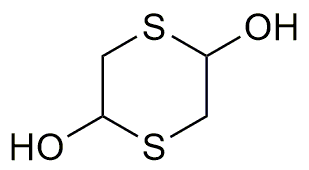2,5-Dihydroxy-1,4-dithiane is widely utilized in research focused on:
- Organic Synthesis: This compound serves as a versatile building block in organic chemistry, enabling the synthesis of various complex molecules. Its unique structure allows for the formation of diverse functional groups, making it valuable in creating pharmaceuticals and agrochemicals.
- Antioxidant Applications: Due to its diol groups, it exhibits antioxidant properties, which can be harnessed in food preservation and cosmetics. This application helps in extending the shelf life of products and protecting skin from oxidative stress.
- Analytical Chemistry: It is used as a reagent in analytical methods to detect and quantify certain metal ions. This is particularly beneficial in environmental monitoring and quality control in manufacturing processes.
- Polymer Chemistry: The compound can be incorporated into polymer formulations to enhance their thermal and mechanical properties. This application is crucial in industries such as automotive and packaging, where material performance is key.
- Biochemical Research: It plays a role in studying biochemical pathways and interactions due to its ability to form stable complexes with biomolecules. This is particularly useful in drug development and understanding metabolic processes.
General Information
Properties
Safety and Regulations
Applications
2,5-Dihydroxy-1,4-dithiane is widely utilized in research focused on:
- Organic Synthesis: This compound serves as a versatile building block in organic chemistry, enabling the synthesis of various complex molecules. Its unique structure allows for the formation of diverse functional groups, making it valuable in creating pharmaceuticals and agrochemicals.
- Antioxidant Applications: Due to its diol groups, it exhibits antioxidant properties, which can be harnessed in food preservation and cosmetics. This application helps in extending the shelf life of products and protecting skin from oxidative stress.
- Analytical Chemistry: It is used as a reagent in analytical methods to detect and quantify certain metal ions. This is particularly beneficial in environmental monitoring and quality control in manufacturing processes.
- Polymer Chemistry: The compound can be incorporated into polymer formulations to enhance their thermal and mechanical properties. This application is crucial in industries such as automotive and packaging, where material performance is key.
- Biochemical Research: It plays a role in studying biochemical pathways and interactions due to its ability to form stable complexes with biomolecules. This is particularly useful in drug development and understanding metabolic processes.
Documents
Safety Data Sheets (SDS)
The SDS provides comprehensive safety information on handling, storage, and disposal of the product.
Product Specification (PS)
The PS provides a comprehensive breakdown of the product’s properties, including chemical composition, physical state, purity, and storage requirements. It also details acceptable quality ranges and the product's intended applications.
Certificates of Analysis (COA)
Search for Certificates of Analysis (COA) by entering the products Lot Number. Lot and Batch Numbers can be found on a product’s label following the words ‘Lot’ or ‘Batch’.
Número de catálogo
Número de lote/lote
Certificates Of Origin (COO)
This COO confirms the country where the product was manufactured, and also details the materials and components used in it and whether it is derived from natural, synthetic, or other specific sources. This certificate may be required for customs, trade, and regulatory compliance.
Número de catálogo
Número de lote/lote
Safety Data Sheets (SDS)
The SDS provides comprehensive safety information on handling, storage, and disposal of the product.
DownloadProduct Specification (PS)
The PS provides a comprehensive breakdown of the product’s properties, including chemical composition, physical state, purity, and storage requirements. It also details acceptable quality ranges and the product's intended applications.
DownloadCertificates of Analysis (COA)
Search for Certificates of Analysis (COA) by entering the products Lot Number. Lot and Batch Numbers can be found on a product’s label following the words ‘Lot’ or ‘Batch’.
Número de catálogo
Número de lote/lote
Certificates Of Origin (COO)
This COO confirms the country where the product was manufactured, and also details the materials and components used in it and whether it is derived from natural, synthetic, or other specific sources. This certificate may be required for customs, trade, and regulatory compliance.


